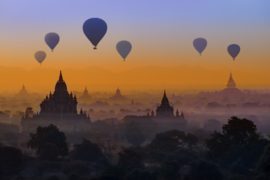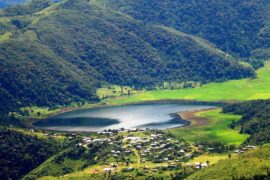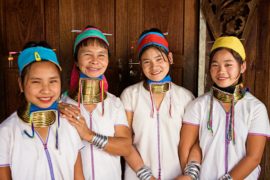When I came to Myanmar for the first time in 1997 at the age of 17, I brought with me a copy of Lonely Planet’s Myanmar guidebook. Although the book was written in English, my formal school education from Germany provided me with a sufficient grasp of the language to follow it. That year, my grandparents had invited me to visit them at their second home, Yangon, and they encouraged me to study a bit about Myanmar before I arrived. Thus, Lonely Planet was my first choice.

Quite soon, however, I found myself searching for the “about the authors” page in my guide book. Fascinated by “this country“ (an allusion to Hillary Clinton’s visit to Myanmar in 2011, when she found herself in a dilemma over how to address Myanmar after years of sanctions imposed by the US), I wanted to learn about the authors who had managed to write a book about a country that to me used to be a hidden place where parts of my family had lived – and no other foreigner, as I had misleadingly thought. Being young, I thought there must be no cooler job on earth than writing travel guidebooks.
Seventeen years and numerous visits to Myanmar later (my grandparents had departed in 2008 after finishing their lifetime work, the first and only German-Myanmar dictionary after 25 years), not only had my spoken English skills evolved dramatically because of my interaction with many other foreigners in Myanmar, but I also found myself having signed a contract with one of Germany’s leading travel-guide publishing houses.
It turned out that at the annual ITB Berlin convention – the world’s largest tourism convention – the publisher had asked some tour operators if they knew someone who could write a travel guidebook about Myanmar. I was in Yangon then, staying in a condo that belonged my grandmother’s first student of German language from the 1960s, when I found an email in my inbox: “We were told that you perhaps are capable of writing a travel guidebook about Myanmar. I am looking forward to hearing from you.”
As excited as I was, I flew back to Germany, signed the contract, bought a new camera and flew back to Yangon on a one-way ticket. The Myanmar embassy to Germany was most supportive and had granted me a one-year visa to finish my book.
When we met in Yangon, a fellow German travel guidebook author on Myanmar (working with a different publisher) told me of a survey that indicated, out of all authors, those who wrote about cars and those who wrote travel guidebooks were regarded as the most corrupt in the eyes of the public. This was because many were thought to accept bribes and enjoy certain benefits.

A riverboat on the Chindwin – Photo: Tobias Esche
I was puzzled! I am a travel writer, I thought: Why aren’t hotel owners and restaurants throwing money at me, or at least giving me free-of-charge arrangements?
Of course, it never even crossed my mind to pursue such favours, as I thought it was not right. Perhaps that’s why, in a different context, one Yangon hotel owner once told me over beers, “Tobias, you are way too honest.” I even had a hard time selling my advertising pages to hotels, travel agencies and the like, something I thought would be an easy task.
Of course, at the time of my research, Myanmar had only 1 million visitors annually, and no one thought it was necessary to invest in advertising. Furthermore, I was writing the very first edition from scratch, which meant I didn’t have anything to show potential advertising partners as proof of my work.
The hardest part, though, was that I was the only author. Other Myanmar guidebooks – including Lonely Planet – are products of a joint authorship of three or more people. I did invite former fellow students from the School of Asian and African Studies in Berlin to contribute to certain topics, such as Myanmar music, literature and language. But today I wish I had invited more contributing authors to cover other aspects, such as the “Before you travel” part – always the most boring part – and other related chapters. That’s because, to me, everything in Myanmar is normal, having become so accustomed to it.
While writing this article during my annual visit to Germany for book presentations, however, I am confronted with the most basic questions prospective travellers to Myanmar can possibly have, such as safety, sickness, exchange rates, restaurant business hours – and, of course, the weather.
Today, if I were asked to write a travel guide book again, I would make a sketch on my wallpaper at home first, listing all the topics, chapters, subchapters and single elements, and then start to include contents. As it was, after spending days out and about, I spent the nights bringing order to the chaos I had accumulated during daytime. The manuscript kept growing and growing. Additonally, a photo index had to be compiled to allocate the mere 300 photos I had space for out of the several thousand I took.

Tobias Esche – shown above in Lashio, after being invited to join in on the wedding of a local police officer
– is the author of Myanmar – Unterwegs im Land der weißen Elefanten.
Maps were another challenge. I collected any that were freely available, and then I added places that I had mentioned in my manuscript that were not already shown. In most places, such as Lashio and Innwa to name just a few, I had to rely on Google Maps and my smartphone, where I had stored waypoints for certain places with my built-in GPS. For instance, there were two pagodas outside Lashio but no map showing them at all. In the end I spotted them on Google Earth and included their geodata on my handmade map.
Technology did let me down once though. One day close to the deadline my computer failed to work, and I lost my whole Yangon chapter without a hard-copy printed. I spent 48 hours with almost no sleep to rewrite 50-plus pages.
The most important matter was only put to rest the night before the book went to the printer: its title. For many months my book was listed on Amazon as Traveling the Land of the Golden Pagodas, which I never liked. I was hard-pressed to think of a better title, though, until it came to me at around midnight: Traveling the Land of the White Elephants. It was a reference to Myanmar’s historical dynasties, and luckily I had covered that topic in my manuscript adequately and provided related photos as well.
But what no one else knew, until now, is that my grandfather had published a book in 1979, the year I was born, titled The Land of the White Elephants – Burmese impressions. It was only fitting as, on my very first evening in Yangon in 1997, he had taken me out to a restaurant for fried rice and beers, and when he asked me if I liked it in Myanmar, I replied, “I certainly will come back.”
Published 19Sept 2014 in Myanmar Times – Travel Edition





Comments are closed.